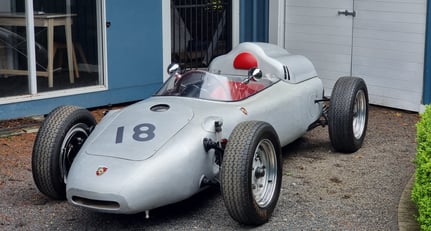-
Baujahr1960
-
AutomobiltypEinsitzer
-
Chassisnummer718-05 R
-
RennwagenJa
-
ZustandNeu
-
Markenfarbe außenAluminium Silver
-
InnenfarbeRot
-
Markenfarbe innenRed Vinyl
-
Zahl der Sitze1
-
Standort

-
AußenfarbeSilber
-
GetriebeManuell
-
Antrieb2wd
-
KraftstoffPetrol
Beschreibung
1960/61 Porsche 718 F2/F1
The FIA announced at the end of the 1958 season, that from 1961 onwards F1 would be run to the then current F2 regulation of 1.5 liter capacity.
Porsche realized that those regulatory changes could give them a clear advantage, having run 1.5 liter 718 RSK center seaters in F2 already as early as 1957 with great success.
In late 1958 Porsche decided to design and build their very first monoposto open wheeler. Porsche managed to have one example of the 718/2 ready for the season starter at the 1959 Monaco GP. Unfortunately Wolfgang von Trips, nicknamed von Crash managed to put it into the wall towards the end of lap 1.
For the rest of the 1959 F2 season the 718/2 prototype makes an appearance at the Rheims GP, where it manages a 3rd in class and at Brands Hatch where it records its 1st in class and 4th overall. On both occasions the single seater is driven by Joakim Bonnier.
These encouraging results lead to a full assault for the 1960 F2 season with the prototype being revised and four more cars being constructed. The 718/2’s did so well throughout 1960,that Porsche managed to secure the F2 World Championship for that year.
Porsche is in good shape for the start of the 1961 F1 season with its 718/2’s elevated to F1 status. Dan Gurney is robbed of Porsches first World Championship F1 win by Ferrari, with Giancarlo Baghetti beating him to the line by 0.1 of a second. This puts Giancarlo in the history books as the only F1 driver to win on his maiden GP outing. Ironically, it’s Baghetti who gives Porsche its first ever F1 win later the same year at the Vallelunga GP near Rome. This interesting but very little known fact has been buried in the F1 racing annals.
Porsche finishes the 1961 F1 season equal third in the drivers’ championship with Gurney and Moss out classed by the shark nose Ferrari ‘s of Phil Hill and von Trips.
The 718/2 carries the flag for Porsche in F1 thanks to a dedicated group of company loyal privateers. By the end of the season Ferry Porsche pulls the plug on his F1 program to focus on its sports car racing programs. The 718/2’s continue in F1 in private hand until 1964.
Carol de Beauforts tragic death during practice of the 1964 Nurburgring in his 718/2 is the final curtain call for Porsche in F1. A five year long active carrier is almost unheard of for any race car. Constant technological advances and rule changes ensure that racing cars become obsolete very quickly.
Of the 5 cars built, 718/2-05 was the factories test mule. Constantly undergoing changes in order to keep the 718/2 compatible it is also the very first Porsche to be fitted with a flat fan configured engine. Changes to bodywork , engine and suspension was rapid, changing its appearance from race to race. Period photos clearly record these alterations and add to some of the confusion.
In its final form 718/2-05 had morphed into a crude and well worn test vehicle. At its final race at Zandvoort GP Holland in 1962 it was driven by local Dutch Porsche dealer and racer Ben Pon. Live footage shows him losing control and plowing into the dunes which surround the track. Pon was very lucky to escape with his life and the car was shortly after scrapped by the factory.
Fast forward 60 years and we are looking at the re-creation of 718/2-05 with its beautiful early bodywork and flat fan engine configuration. It’s been 5 years in the making and is the culmination of almost 10 000 man hours and an unbreakable determination to have this historic race car turn its wheels in anger once again.
The brief at Hardt Classics, who’s business is restoring early Porsches with 30 years experience, was not a simple one, source original blue prints and as many period correct Porsche component as possible to build this car. A wooden body buck was constructed to form the aluminum skin over. The tubular space frame was constructed from cold drawn seamless tubing and great care was taken to assemble everything using techniques and parts used in period.
From sourcing correct type lightweight steel/alu wheels to fitting massive 60 mm finned drum brakes, every effort was made to produce a vehicle that not only visually would have the correct impact, but could also perform. The engines flat fan configuration is similar to the later Elva Porsches, fiberglass racers built with Porsche mechanicals in England in period, using a complex bevel gear arrangement to efficiently pump enough air across the engine at high RPM’s. Oil is pumped to a front oil cooler using period correct blue braided steel lines sourced from Germany. The braided lines can be seen on 718 and 804 race cars in period. All this creates the correct visual and visceral impact to treat the driver to a full blown analog racing experience
This is where all the years of working on early Porsches paid off, understanding that back in the early sixties the Porsche race department consisted of only a small group of handpicked, multi skilled people who created these amazing machine not only with limited resources but also under constant pressure to get the job done for the new race season. The logic on how things were done with what was available made our respect for these men grow by the day.















































































































